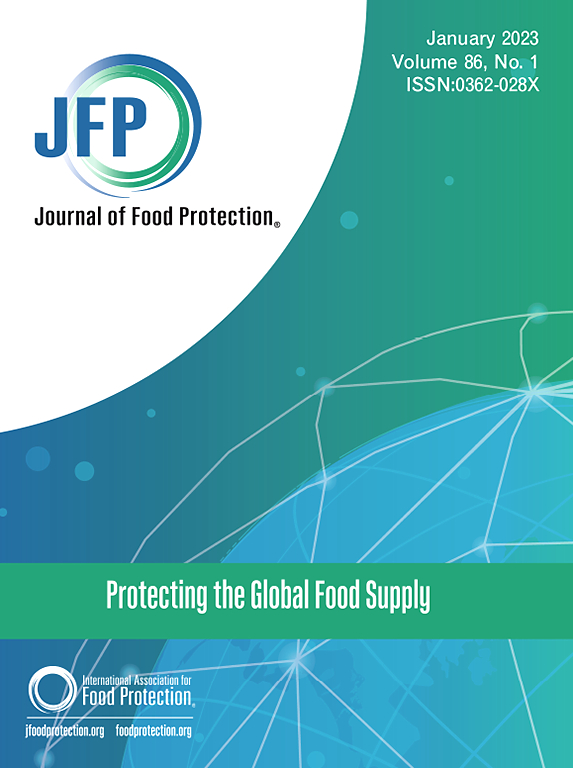评估 16s 长读数元条码在确定零售禽肉微生物组和沙门氏菌污染特征方面的应用。
IF 2.8
4区 农林科学
Q3 BIOTECHNOLOGY & APPLIED MICROBIOLOGY
引用次数: 0
摘要
肉制品中沙门氏菌检测的传统金标准是细菌培养富集法。虽然这种方法是高度敏感的,但它是缓慢的,并提供了一个不完整的阳性样品分离分类评估。本研究提出了一种新的基于PCR的检测方法,该方法扩增了16s-ITS-23s区域,该区域是较大核糖体rrn操纵子的约2500个碱基对区域。通过将每个生物样品分成3个技术重复来评估测定内变异。检测限(LOD)是利用连续稀释纯培养肠沙门氏菌亚种评估。在沙门氏菌培养阴性的鸡肉样品中加入无菌的1倍PBS或1倍PBS冲洗液。结果表明,本文评估的16s元条形码分析不能可靠地用于检测掺假零售肉类样品中的沙门氏菌,因为观察到的LOD为4.70 log菌落形成单位(CFU)/ml,高于零售家禽肉类样品中沙门氏菌的预期浓度,而先前的研究表明,沙门氏菌的浓度范围在1至2 log CFU/ml以下。然而,由于使用16s长读数提供了更高的分类分辨率,该试验允许对生禽肉微生物组进行α多样性评估,并能够对一些扩增子序列变异(ASV)的物种和菌株水平进行分类。这表明,这一过程可能有价值,在禽肉生产过程的早期步骤中,细菌污染浓度可能较高的家禽样品的生物多样性和病原体污染特征。本文章由计算机程序翻译,如有差异,请以英文原文为准。
Evaluation of 16s Long Read Metabarcoding for Characterizing the Microbiome and Salmonella Contamination of Retail Poultry Meat
The traditional gold standard for detection of Salmonella in meat products is bacterial culture with enrichment. While this method is highly sensitive, it is slow and provides an incomplete assessment of isolate taxonomy in positive samples. This study presents a novel PCR-based detection assay which amplifies the 16s-ITS-23s region which is an approximately 2,500 base pair region of the larger ribosomal rrn operon. Intra-assay variation was assessed by splitting each biological sample into 3 technical replicates. Limits of detection (LOD) were assessed by utilizing a serial dilution of a pure culture of Salmonella enterica subsp. enterica serovar Heidelberg spiked into either sterile 1 × PBS or 1 × PBS rinsate of a Salmonella culture-negative chicken meat sample. Results indicate the 16s metabarcoding assay evaluated here could not be reliably used for the detection of Salmonella in adulterated retail meat samples as the LOD observed, 4.70 log colony forming units (CFU)/ml, is above the expected concentration of Salmonella in retail poultry meat samples which previous studies have shown range from under 1 to 2 log CFU/ml. However, due to greater taxonomic resolution afforded by using 16s long reads, the assay allowed alpha diversity assessment of the microbiome of raw poultry meat with the ability to assign taxonomy to the species and strain level for some amplicon sequence variants (ASV). This indicates this process may have value characterizing biodiversity and pathogen contamination of poultry samples in earlier steps of the poultry meat production process where bacterial contamination concentrations are likely to be higher.
求助全文
通过发布文献求助,成功后即可免费获取论文全文。
去求助
来源期刊

Journal of food protection
工程技术-生物工程与应用微生物
CiteScore
4.20
自引率
5.00%
发文量
296
审稿时长
2.5 months
期刊介绍:
The Journal of Food Protection® (JFP) is an international, monthly scientific journal in the English language published by the International Association for Food Protection (IAFP). JFP publishes research and review articles on all aspects of food protection and safety. Major emphases of JFP are placed on studies dealing with:
Tracking, detecting (including traditional, molecular, and real-time), inactivating, and controlling food-related hazards, including microorganisms (including antibiotic resistance), microbial (mycotoxins, seafood toxins) and non-microbial toxins (heavy metals, pesticides, veterinary drug residues, migrants from food packaging, and processing contaminants), allergens and pests (insects, rodents) in human food, pet food and animal feed throughout the food chain;
Microbiological food quality and traditional/novel methods to assay microbiological food quality;
Prevention of food-related hazards and food spoilage through food preservatives and thermal/non-thermal processes, including process validation;
Food fermentations and food-related probiotics;
Safe food handling practices during pre-harvest, harvest, post-harvest, distribution and consumption, including food safety education for retailers, foodservice, and consumers;
Risk assessments for food-related hazards;
Economic impact of food-related hazards, foodborne illness, food loss, food spoilage, and adulterated foods;
Food fraud, food authentication, food defense, and foodborne disease outbreak investigations.
 求助内容:
求助内容: 应助结果提醒方式:
应助结果提醒方式:


